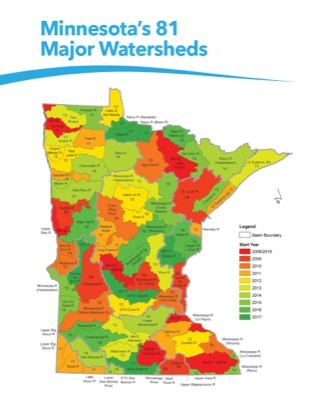
1) MONITORING & DATA ASSESSMENT: Minnesota’s 10-year Watershed Restoration and Protection Strategy cycle starts with data collection and analysis. 2) STRATEGY: Stream data and agricultural, social and project information are reviewed, then a strategy is written, reviewed and used to inform County watershed plans. 3) PROTECTION: Guided by the strategy, organizations and volunteer citizens do the work of restoration and protection.
The condition of streams, lakes and rivers depends primarily on the actions of people on the land draining to them. In other words, what you do affects me and what I do affects you. It’s the most basic kind of community.
To help Minnesotans work together to protect water in their own neighborhoods, a new approach was adopted by Minnesota in 2008, implemented in applicable program areas by the Pollution Control Agency, Department of Natural Resources, Board of Water & Soil Resources, Department of Health, and Department of Agriculture. The first three parts of the process below, led by the Pollution Control Agency, are called Watershed Restoration & Protection Strategies or WRAPS, for short.
The state’s 81 watersheds are now managed in a cycle, with four things done every 10 years in every watershed:
1) MONITORING For two years, watershed conditions are intensively monitored by the Pollution Control Agency. Data collected by state, federal and local organizations is compiled. Land use, topography, soils and pollution sources are evaluated.
2) DATA ASSESSMENT Comprehensive watershed teams evaluate data, determine which waters are and are not meeting standards, and identify stressors to aquatic biological communities.
3) STRATEGY Based on the assessment, GIS work, models, local knowledge and plans, geology and technical reports, a strategy is developed by teams of local people and agency specialists.
4) RESTORATION & PROTECTION Projects are implemented cooperatively by state agencies, local watershed districts, counties, municipalities and soil and water conservation districts . Ongoing monitoring is carried out.
What’s happening here?
Our work cycle began in 2010. Historic data was collected, assessed, and a report released in 2012. New monitoring took place and stressors were identified. A strategy now in development will outline actions, time lines, assessment milestones, and a monitoring plan. When finished the strategy will direct work by the Whitewater River Joint Powers Board and inform water plans in Olmsted, Wabasha and Winona Counties.
The goal: Best use of skill, time and money to improve water quality and conditions in our streams.


Strategically Tackling a Big Task
In Minnesota we use a “watershed approach” to assessing, restoring and protecting water quality. One practical goal is to make it easier for individuals, non-government organizations and citizens to work together, to fill gaps and reduce duplication of effort.
Our state’s 81 major watersheds are shown at left. A strategy is developed for each every 10 years, in rotation.
What is a watershed? — An area of land where all water drains to the same river, stream, lake or ocean.

